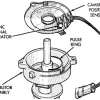The crankshaft position sensor is an engine management component found on almost all modern vehicles with internal combustion engines. It monitors the position and rotation speed of the crankshaft and transmits the information to the engine control unit, so that it can make appropriate adjustments depending on the operating conditions.
Crankshaft speed and position are some of the most important parameters used in engine management calculations and many engines cannot operate if the crankshaft position sensor does not provide an accurate signal.
{{{ad-code}}}
Usually, a problematic crankshaft position sensor will produce some symptoms that warn the driver of a potential problem that should be taken care of.
1. Vehicle starting problems
The most common symptom associated with a faulty shaft position sensor is difficulty starting the vehicle. The crankshaft position sensor monitors the position and speed of the crankshaft and other parameters that play an important role in starting the engine.
If the crankshaft position sensor has a problem, the vehicle may have intermittent starting problems or may not start at all.

2. Intermittent engine problems
Another symptom commonly associated with a problematic crankshaft position sensor is intermittent blockage of the engine . If the crankshaft position sensor or its wiring has problems, it may cause the crankshaft signal to stop while the engine is running, which may cause the engine to stop.
{{{ad-code}}}
This is usually a symptom of a wiring problem. However, a defective crankshaft position sensor can also cause this symptom.
3. Check that the engine warning light is on
Another symptom that highlights a potential problem with the crankshaft position sensor is an illuminated engine control light (Check-Engine light is on).
If the computer detects a problem with the crankshaft position sensor signal, it will activate the engine light to warn the driver of the problem. Ideally, you should scan for errors using an OBD2 scanner.
{{{ad-code}}}
4. Inconstant acceleration
With an inaccurate input from the crankshaft position sensor, the engine control unit cannot make adjustments to timing and fuel injection as the engine speed increases. In this case it is difficult to maintain a constant speed.
5. Engine malfunction or ECU errors
If you feel the engine running as it would be coughing or even hear that it is struggling to run linearly, this may be a sign of the cylinders not working properly due to a faulty crankshaft position sensor. In addition, while idling at a traffic light or the engine is idling, you may notice that the engine is malfunctioning, vibrating and the idle revs are not constant.
{{{ad-code}}}
A crankshaft position sensor that is not in the correct position cannot provide the correct information about the position of the piston in the engine, causing an accidental failure of the cylinder. This can also happen due to incorrect spark plug timing, but if the spark plugs are checked and are in order, then the crankshaft sensor may be the reason.
6. Increasing fuel consumption
In the absence of the correct timing information from the crankshaft position sensor, the fuel injectors will not efficiently pump fuel into the engine. The engine will use more fuel than it needs, obviously greatly increasing consumption. Ask a mechanic to inspect the sensor, as increased fuel consumption may be the result of other problems.
{{{ad-code}}}
The crankshaft position sensor is essential for proper engine functionality and performance due to the vital signal it provides to the ECU. Crankshaft sensor problems can quickly lead to problems that affect the reliability of the vehicle.
For this reason, if you suspect that the crankshaft position sensor has a problem, check it immediately with the help of a professional. They will be able to diagnose the issue and replace the crankshaft position sensor, if necessary.


